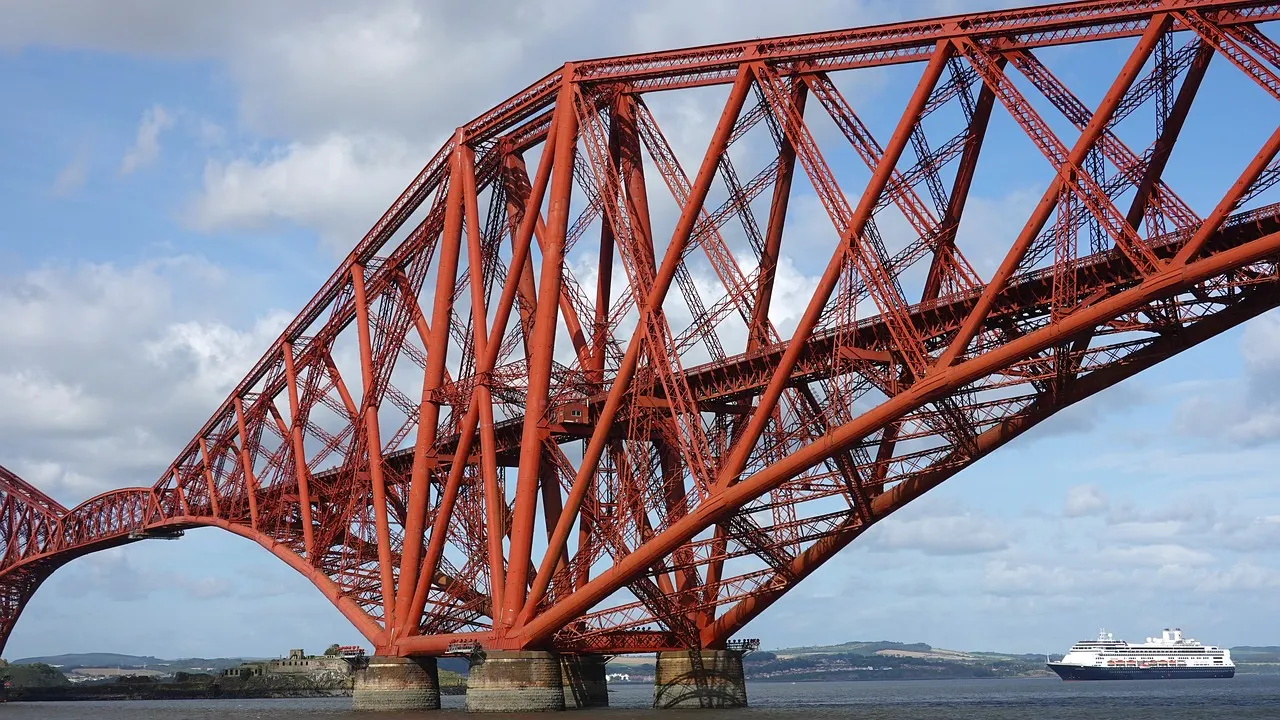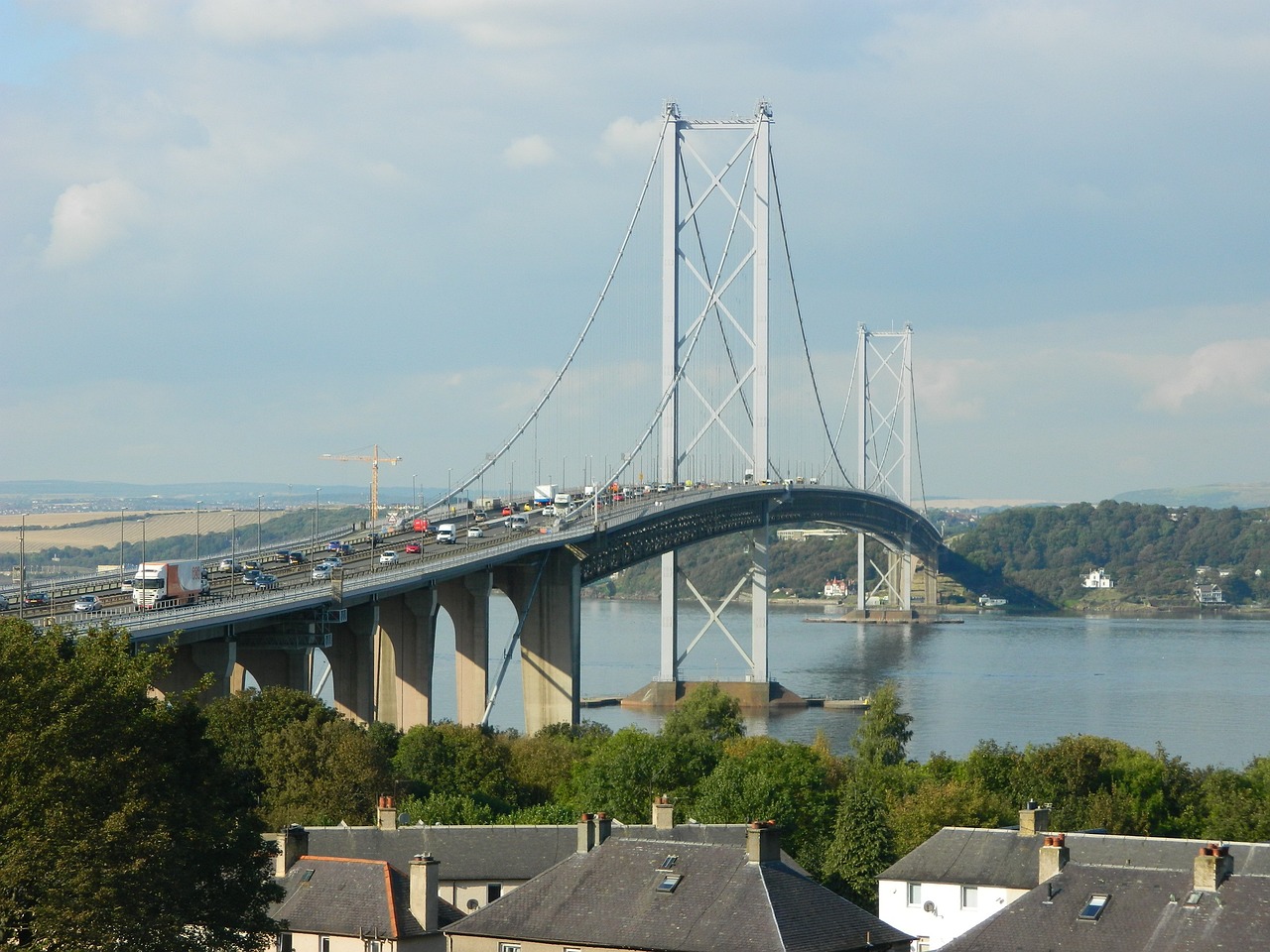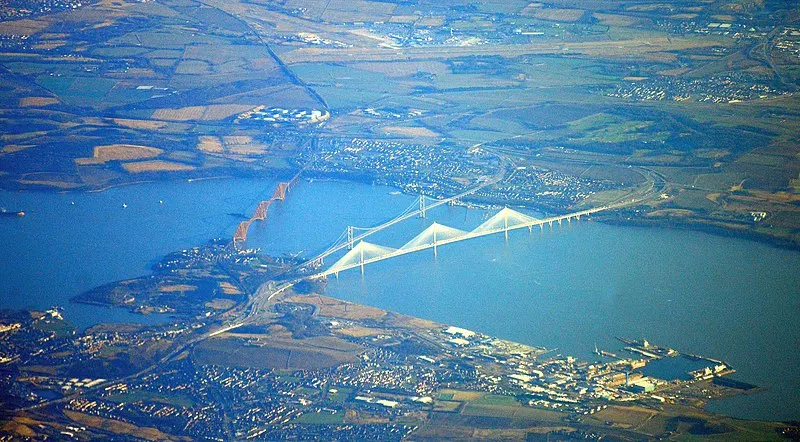The Forth Bridges
The Forth Rail Bridge - The Grand Old Lady of the Forth -1890

The Forth Rail Bridge: An Epic Tale of Victorian Ingenuity
Ah, picture if you will, a scene straight out of a Victorian melodrama: the late 19th century, a time when the very air was thick with the scent of coal smoke and the sound of steam engines chugging along the tracks. It was against this backdrop that the Forth Rail Bridge emerged from the mist like a majestic phoenix, its steel girders gleaming in the morning sun, heralding a new era of transportation in bonnie Scotland.
Conceived amidst the chaos of ferry crossings and the cacophony of the Industrial Revolution, the Forth Rail Bridge was hailed as a stroke of genius, a solution to the logistical nightmares that plagued travellers and merchants alike. Designed by the esteemed duo of Sir John Fowler and Sir Benjamin Baker, this iconic structure was not just a bridge, oh no, it was a marvel of engineering prowess, a symphony of steel and sweat, and perhaps a dash of Victorian eccentricity.
As the plans took shape, Victorian society was abuzz with excitement, imagining the possibilities that lay ahead. But alas, it was not all smooth sailing. Oh no, there were challenges aplenty, from unruly weather to rebellious rivets, each one threatening to derail the grand vision of the bridge builders. Yet, with grit and determination, they pressed on, their spirits as unyielding as the steel they forged.
And so, in 1890, amidst cheers and fanfare, the Forth Rail Bridge stood proudly upon the waters of the Firth of Forth, a towering testament to human ingenuity and the indomitable spirit of the Victorian age. Since then, it has weathered storms and stood the test of time, a timeless monument to the perseverance and craftsmanship of those who dared to dream big and build even bigger. And perhaps, just perhaps, it continues to regale us with tales of its glory days, reminding us that even the mightiest of structures can have a sense of humour.
As the centenary celebrations of the Forth Rail Bridge approached in 1990, anticipation reached a fever pitch across Scotland. This was no ordinary milestone; it was a momentous occasion marking a century of steadfast service and engineering excellence. Plans were laid, festivities arranged, and the excitement in the air was palpable.
On the eve of the centenary, as the sun dipped below the horizon, the Forth Rail Bridge transformed into a beacon of celebration. The majestic QE2, serving as an elegant platform for the grand firework display, awaited in the waters below, poised to add her regal touch to the festivities. As darkness descended, the bridge came alive with a dazzling array of lights, illuminating its towering arches and transforming it into the longest illuminated bridge in the world.
Amidst the awe-inspiring spectacle, an unexpected twist emerged: a curious discovery of rats on the tiny island of Inchgarvie, nestled beneath the bridge's majestic span. While initially met with surprise, the incident only served to add a touch of whimsy to the celebrations, becoming a humorous anecdote shared amongst locals and visitors alike.
As the fireworks painted the night sky with bursts of colour and the Forth Rail Bridge basked in its newfound glory, it became a symbol not just of engineering prowess, but of the indomitable spirit of Scotland. It stood as a testament to perseverance and innovation through triumphs and challenges, reminding all who beheld it of the power of human ingenuity and the beauty of collective achievement. And so, as the centenary celebrations drew to a close, the Forth Rail Bridge remained a beacon of inspiration, casting its majestic silhouette against the backdrop of the Scottish landscape for generations to come.
The Forth Road Bridge - 1964

The Forth Road Bridge: A Testament to Modernity and Progress
In the swinging sixties, a bold vision emerged from the misty shores of Scotland, embodied in the sleek and futuristic design of the Forth Road Bridge. This architectural marvel, born out of necessity to bridge the gap between the bustling metropolis of Edinburgh and the quaint shores of Fife, captured the collective imagination of a nation poised on the cusp of a new era. As the longest suspension bridge in Europe upon its completion in 1964, it not only revolutionized travel but also symbolized the spirit of progress and connectivity that defined the decade.
Gone were the days of tedious ferry crossings and lengthy detours. With the Forth Road Bridge, commuters and travellers alike could now traverse the Forth estuary with ease, their journeys transformed into swift and seamless experiences. Its towering steel cables, stretching gracefully across the horizon, were a testament to the ingenuity and ambition of the human spirit. From its grand opening, it became an enduring symbol of modernity, symbolizing Scotland's readiness to embrace the challenges and opportunities of the future.
As the decades passed, the Forth Road Bridge stood as a beacon of progress, weathering storms both literal and metaphorical. Its iconic silhouette became an integral part of the Scottish skyline, a reminder of the feats of engineering and the dreams of those who dared to push the boundaries of possibility. Today, as its successor, the Queensferry Crossing, carries on its legacy, the Forth Road Bridge remains a cherished landmark, forever etched in the hearts and minds of all who have travelled its span.
The new 'Queensferry Crossing' - 2016 -2018

Ah, the Queensferry Crossing, the shiny newcomer to the Forth family, making its debut on the Scottish scene in 2017 with all the flair of a celebrity stepping onto the red carpet. With its sleek design and twinkling lights, it's like the cool kid on the block, strutting its stuff while the older bridges nod in approval. Picture this: a cavalcade of cars gliding effortlessly across its lanes, commuters tapping their fingers to the beat of their favourite tunes, and wide-eyed tourists snapping selfies in front of its architectural splendour.
But behind the polished facade lies a tale of modern engineering, with a healthy dose of humour thrown in for good measure. From the drawing board to the construction site, the Queensferry Crossing had its fair share of antics and mishaps along the way. There were design debates that rivalled the most heated of parliamentary sessions, with architects and engineers wrangling over every detail, from the curve of the arches to the hue of the lights.
And then there were the winter woes, a recurring theme in the Forth Bridge saga. The Queensferry Crossing, with all its modern sophistication, was not immune to the icy antics of Mother Nature. When winter descended upon the Forth estuary, it was as if the bridge had donned its icy crown, causing traffic chaos and headaches for commuters. Well, falling shards of ice from the suspension cables will do that to most commuters. But fear not, for even in the face of frosty adversity, the Queensferry Crossing stood tall, its elegant silhouette a testament to human ingenuity and the power of perseverance.
So the next time you find yourself traversing the lanes of the Queensferry Crossing, take a moment to appreciate the journey that brought it to life. From conception to construction, it's been a rollercoaster ride of innovation, humour, and the occasional icy escapade.
And as you cruise across its shimmering expanse, remember to tip your hat to the engineers, architects, and daredevil cyclists who made it all possible.
As you traverse the Queensferry Crossing and cast your gaze to the right, prepare yourself for a glimpse into the storied past of the Forth estuary. There, nestled upon its tiny island like a stalwart guardian, stands the historic fort on Inchgarvie. This formidable fortress, with its weathered walls and rugged charm, is a testament to the strategic importance of the Forth in centuries past.
But it's not just any old fort – oh no. This is the very same stronghold that once played a pivotal role in defending against the infamous American pirate, John Paul Jones. Yes, you heard that right – John Paul Jones, the scourge of the high seas, whose name struck fear into the hearts of sailors far and wide.
Legend has it that John Paul Jones, with his cunning and audacity, set his sights on the Forth estuary, intent on plundering its riches and wreaking havoc upon its shores. But the brave defenders of the fort on Inchgarvie were ready and waiting, their cannons primed and their resolve unyielding. As Jones and his crew approached, they were met with a barrage of cannon fire that sent them scurrying back to the safety of the open sea, tails between their legs.
Ok, that might not have been the case, however, truth be told, despite the rumours of JPJ making an imminent arrival, he never left the West Coast and the fort was never used! Edinburgh and the Forth were never attacked.
